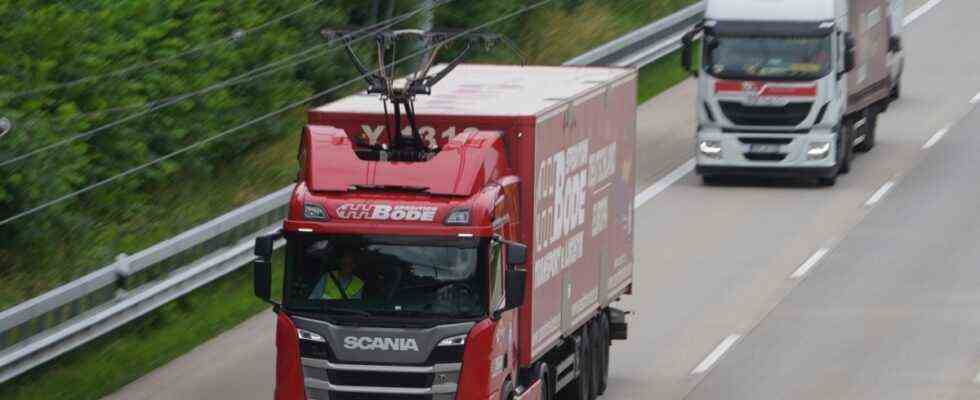As far as transporting people is concerned, the principle has been known since the 19th century: in 1882 a certain Werner Siemens, at that time still without “von” in the name, presented a bus with an electric motor. This bus obtained the electricity it needed from an overhead line, just like the electric tram, which was introduced a year earlier. Trolleybuses still run through many cities, from Salzburg via Minsk and Moscow to Beijing and São Paulo, in Germany through Solingen, Esslingen and Eberswalde. But in freight traffic, overhead lines have so far almost exclusively run over railroad tracks. The Bavarian state government and the Federal Ministry of Transport now want to change that, at least on a test basis. The A 9 between Munich and Nuremberg, or alternatively the A 92 in the direction of Deggendorf, is to become the “E-Highway Bavaria”.
The Free State proposed the project to the Federal Ministry of Transport, headed by CSU Minister Andreas Scheuer, which, according to its own paper, has promised a “low to mid three-digit million amount”. The money could come from the federal energy and climate fund, according to the ministry, which will of course no longer be led by Andreas Scheuer with some probability after the federal election. There has not yet been a firm funding commitment.
Because so far it has not even been decided whether the contact wires for new types of electric trucks should now be stretched over the right lane of the A 9 between Munich, Ingolstadt and Nuremberg or on the A 92 via Landshut and Dingolfing towards Deggendorf. Otherwise there are hardly any details. The Bavarian Ministry of Transport wants to define this in a joint project group with the forwarding and logistics associations.
Simply electrifying heavy trucks with the help of batteries, as is now the case with many smaller and larger cars and vans, has so far not been seen as promising. Because in order to be able to transport large loads over long distances in this way, the batteries themselves would have to be much too heavy and bulky. It would be different if the trucks were able to obtain the electricity for their engines for at least a large part of the route via overhead lines and then charge their batteries on the way. The batteries, in turn, are necessary so that the trucks can leave the electrified lanes and motorway sections and not just hang on the overhead line and are therefore set to pure line operation like the trolleybuses in local transport. Overall, the technology is considered to be far more energy-efficient and therefore cheaper and much more climate-friendly than conventional diesel engines, although the size of the climate effect depends on how the electricity is generated.
The fact that electrically powered trucks can in principle be supplied with electricity via overhead lines no longer necessarily has to be proven by the envisaged Bavarian “innovation cluster”. To this end, Siemens and the truck manufacturer Scania equipped a two-kilometer section of the motorway in Sweden with an overhead contact line back in 2016. In Germany there are now three test routes with the A 5 near Frankfurt am Main, the B 462 between Kuppenheim and Gaggenau in Baden-Württemberg and the A 1 between Reinfeld and the Lübeck junction in Schleswig-Holstein, on which the Federal Environment Ministry has commissioned the Catenary technology is being researched. A total of eight overhead line trucks were last on these routes. The prototypes have pantographs such as an electric locomotive and electric motors. In addition, they still have internal combustion engines.
According to the Ministry of Transport in Munich, part of the Bavarian pilot project will be “a dense network of stationary charging facilities and hydrogen filling stations” in order to be able to experiment with a combination of different drive technologies. In order to be able to charge battery and fuel cell trucks while driving, the electrified route must have a certain length. Ideally, it should therefore be much longer than the other German test tracks, which also means that the overhead contact line must then be compatible with bridges or other transverse structures such as the gantries. According to a spokesman, the federal motorway company is therefore tending slightly towards the A 92, especially since a system was recently installed on the A 9 with some effort that can open the hard shoulder as an additional and, in this case, right-hand lane.
According to Bavaria’s Transport Minister Kerstin Schreyer (CSU), the selection of the test route will be the first task of the new project group. A decision could be made this year. “We want to get the overhead line trucks on the road as quickly as possible,” emphasizes Schreyer. Researchers have long been working on a power supply using induction through coils under the asphalt. That would make overhead lines unnecessary and could also supply cars.

